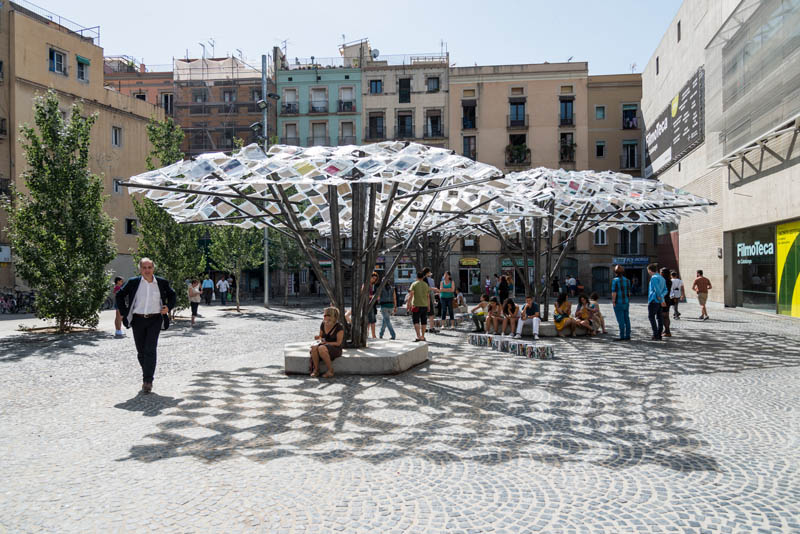Barcelona ReSet: Urban public installations August-September 2014
By Shea Gilligan On September 11, Catalonia commemorates the 1714 Siege of Barcelona defeat that meant the loss of independence, the abolition of all Catalan institutions, constitutions, rights and freedoms, and the beginning of a centuries-long persecution for the culture, traditions and language of its people. via website http://www.helpcatalonia.cat/p/special-edition-september-11th-national.html
Each year, on September 11, those Catalonians who died defending the city Barcelona are remembered, and the spirit of those citizens and their culture is celebrated in a citywide festival. This year marks the 300th anniversary of that symbolic day, and so the Barcelona Cultura enlisted the Fundació Enric Miralles headed by architect Benedetta Tagliablue (EMBT) and stage director Àlex Ollé to curate seven public installations on historically significant sites in Barcelona as part of its Tricentenari BCN program. The installations address six themes, namely, identity, freedom, Europe, diversity, democracy and memory.
Invitations were distributed globally to selected guest architects to collaborate with local universities to create the public exhibits throughout Barcelona. Architexx turns our attention to two installations by women-led firms.
The first is by Studio Odile Decq. The firm is headed by Odile Decq who opened the office promptly after her graduation from La Villette in 1978. Her long-standing practice is committed to the investigation of issues often overlooked in more mainstream architecture & design, such as her Frac Bretagne musuem, a contemporary art space, designed to haptically lead visitors vertically through the building. For her outstanding and non-conventional work, Decq was awarded the Woman in Architecture Prize “Prix Femme Architecte” in 2013. Decq has served as department head of the Ecole Spéciale d’Architecture since 2007, and building off of her work in education, Decq launched a pedagogically progressive architecture school, Confluence, in Lyon, France.
For the Tricentenari BCN program, Studio Odile Decq designed an installation of 300 black t-shirts, each bearing a print of a face over the Placa del Angels. The number of shirts is a reference to the 300 years since the Siege of Barcelona. The suspension of the t’s is a homage to the traditional way of drying clothing and the use of the t-shirt brings an implicit reference to commonplace needs of the body on an architectural scale. The faces on the t-shirts are ethnically diverse, explaining Barcelona’s history as a rich and changing one. Because the medium of the t-shirt and the style of the portraiture is so standardized, sub_teXXt recognizes the installation as a remark on the universal nature of the materials we need to live, transcending apparent differences.
Image Source: http://www.mahala.org/public/inforeset/140328_Bcn%20Reset%20projects.pdf
Shown above the schematic design, and below the actual installation.
Photo courtesy of Nina Freedman
Our second spotlight installation is by Anapama Kundoo, an architect known for her innovation in low-impact building technologies, and her commitment to socio-economically beneficial projects, such as Kundoo's invention of the terracotta interlocking tube, best described on her own website as; "Hollow burnt clay tubes are stacked to achieve catenary vaults that require no structural steel. Substructure such as wooden rafters in terracotta roof tile applications are redundant as the system is self supporting. Neither is shuttering required. This leads to an insulated roof based on locally produced materials and quick assembly." Her practice demonstrates a strong focus on material research, innovation and forging new kinds of construction prototypes based on function, performance and health. Since 1990, Kundoo has realized an impressive number of built projects. In addition to her successful career, Kundoo has remained committed to her role as educator and continues to teach worldwide.
Image Source: http://barcelona.b-guided.com/en/noticias/b-ing/bcn-re-set-ephemeral-urbanism-528.html
In her installation, Unbound: The Library of Lost Books, Anapama Kundoo uses the pages of books as a raw material, constructing a tree canopy with laminated loose leaves of the pages. Kundoo’s theme, ‘Freedom/liberty’, as well as the choice of the literary material illustrates the analogy between education, knowledge and freedom. The experimental form of the installation, using the branching frame to hold up the translucent, undulating canopy points to a freedom from traditional building practices as well. In the company of the other shade structures built for the Tricentenari BCN program, Kundoo’s forms appear natural, a tree and it’s leaves reconstituted. The “freedom” of her title, in the context of the cumulative forms, as well as the reference to multiplicity of sources, seems to refer to a community’s freedom, rather than defiant individual expression.
Photo Courtesy of Nina Freedman





